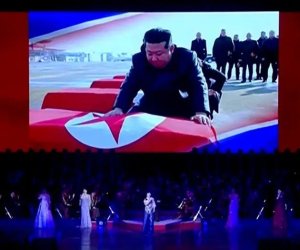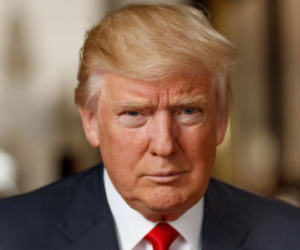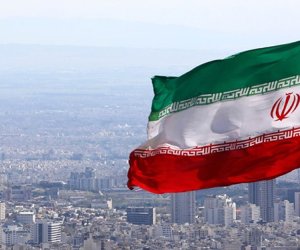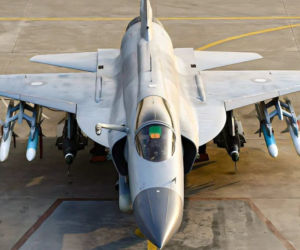Ukrainians fear Russian invasion in northeast

"We can't expect help from anybody else. Our own government is too passive. But hopefully we can rely on support from ordinary Ukrainians," Vladimir Fedorok told CNN on a blustery morning close to the Ukrainian border village of Senkivka.In more peaceful times, Fedorok runs a farm supplies company. Now, with Russia estimated to be massing up to 88,000 troops just across the border from Ukraine's eastern frontier, he finds himself marshaling a newly formed self-defense committee. They're setting up an outpost along the highway that cuts from the Ukrainian-Russian border to the Ukraine's interior.He and his closest aides, Younis and Olec, are clad in British Army-issue uniforms from the Iraq "Desert Storm" campaign. They still bear the Union Jack insignia on the left sleeve."We picked them up at the bazaar. I've no idea how they got there. Including my boots, I paid around 100 euros," Fedorok said. Other members of his self-defense unit are sporting surplus combat jackets and pants from other European militaries.All of the volunteers say they have some army training from time spent doing military service. Fedorok said they've also been getting refresher courses from friendly Ukrainian army officers in recent days. Two members of the group claim -- like an unspecified number of other Ukrainian nationalists -- to have fought alongside Muslim insurgents against the Russians in Chechnya.Best hope is to slow any advanceBut if the Russians roll into eastern Ukraine, it will be very different from the house-to-house urban combat that has previously taken place in the Chechen capital of Grozny.This region is home to sweeping expanses of farmland and scattered forests, classic terrain for a tank war -- the kind of scenario both Soviet and NATO forces drilled for during the Cold War years.Fedorok and his patriots have encircled their dilapidated outpost with piles of old car tires. The plan: If the Russians stream down the highway en route to the district capital Chernigov, they'll burn rubber and set up a smokescreen.They say they have no real weapons, but this band of brothers has made up a stash of Molotov cocktails, with rags stuffed into old vodka bottles. The few yards of trenches that stretch into a nearby tree line are only a fallback position, and hardly constitute a sturdy defensive line."As much as anything else, we're put here making a political point. We know this outpost is only an effort to slow down the Russians," Fedorok said matter-of-factly."I shouldn't be telling you this but our plan is to break down into five-man units and we will launch a guerrilla-style partisan war against the Russians," he added, declining to specify how many volunteers he has under his command.But these paramilitary militias may not be entirely alone. Fedorok drives a few kilometers up the highway closer to the border to introduce us to a detachment of Ukrainian soldiers.For now, they're coordinating operations. A fresh-faced army major with a Russian-made AK-74S assault rifle slung over his shoulder told us his men are on high alert."These are military times," he said as he showed us a little of his hardware: three armored personnel carriers mounted with heavy-machine guns, dug into the earth and camouflaged with branches from birch trees.A few yards away stood a Russian-made T-80 tank. The major said there were more tanks half buried behind berms in the forest.'Looking toward our brothers'All the vehicles are pointing toward a bridge. The major, who declined to give his name, said the order was to defend the bridge or blow it up if the Russians advanced across the border.But unlike the civilian self-defense militias, these soldiers seem a little unsure when I asked whether they would really stand and battle the Russians.In Ukraine's Crimea region, the Ukrainian army confined itself to barracks or surrendered. Earlier this week, the Defense Ministry in Kiev said a full 75 percent of its force in Crimea either defected or simply went AWOL when the Russians moved in.Here at the eastern border, the major in charge of this armored detachment shook his head slowly."I prefer to say that we are not pointing our tanks at the Russians but merely looking toward our brothers in case they advance in friendship," he said. The major said he could scarcely believe he was on high alert to battle troops from Moscow."We trained in the same military academies during Soviet times and after that. We see them as our brothers," he said.The Pentagon's latest figures put the number of Russian troops massing just over the border at about 40,000. The Ukrainian government's National Defense and Security Council estimates the figure at 88,000, but that estimate may include units a little farther from the border region that could be deployed as a second wave in the event of an invasion.Moscow has insisted it is only carrying out drills. And in televised comments Saturday, Russian Foreign Minister Sergey Lavrov insisted his forces had no intention of crossing into Ukraine.However, in a telephone conversation with President Barack Obama Friday night, Russian President Vladimir Putin once again reportedly raised concerns about ethnic Russians living in eastern Ukraine.He suggested Ukrainian ultra-nationalists had been threatening ethnic Russians and driving them out of their homes and businesses -- the same accusations that Moscow used as a pretext to intervene in Crimea.Standing tall and surveying his trench lines, self-defense commander Fedorok was in no mood to listen to any assurances from Moscow.He said he was in no doubt: "The Russian hordes are coming."(CNN)ANN.Az
Latest news 
More news 



































 Photo
Photo 



 Video
Video 

